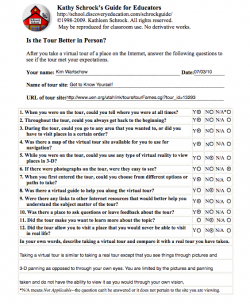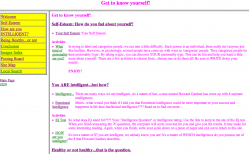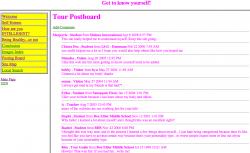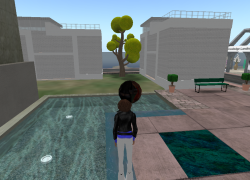Inquiry 598
Twitter & Learner Control
| twitter_and_learner_control.docx |
Twitter Activities
I have mainly just used twitter for social networking junk so far. I have posted several useless updates for no reason at all. It's not like the world needs to know what I am doing or thinking about every two seconds! My friend Mike posted links to some photos of his little girl at her dance recital which was neat. I thought that was a good way for people to be able to click on the link and see photos without him having to send out a mass e-mail or forget to send something to someone etc. All he had to do was post the link and tell people who asked to go to it! I love the idea of using Twitter for news updates, especially weather updates being sent to my mobile phone! I would love to get weather updates just sent to my phone automatically through Twitter. That would be convenient... the weather report through the ease of text messages! Twitter has a lot of uses that I never even thought of before!
Virtual Field Trip Evaluation
Research Article Correspondence
To: Akshay Java, Tim Finin, Xiaodan Song, Belle Tseng;
I am in a graduate course at Central Connecticut State University on research. I am getting my Masters degree in Educational Technology and I read your research study on Why We Twitter: Understanding Microblogging Usage and Comunities. I really appreciated the information as I am an educator myself and am always looking for new ways to incorporate technology into my teaching. I do no like incorporating technology simply for the sake of adding technology, I like everything I do to have a purpose and be meaningful. I was wondering if you have any more advice for using Twitter in the classroom; either about how it can be used, or examples of ways that you use it in your own classroom. I specifically teach elementary physical education and health (just in case you have any specific examples)!
Thank you,
Kimberly A Wartschow
[email protected]
I am in a graduate course at Central Connecticut State University on research. I am getting my Masters degree in Educational Technology and I read your research study on Why We Twitter: Understanding Microblogging Usage and Comunities. I really appreciated the information as I am an educator myself and am always looking for new ways to incorporate technology into my teaching. I do no like incorporating technology simply for the sake of adding technology, I like everything I do to have a purpose and be meaningful. I was wondering if you have any more advice for using Twitter in the classroom; either about how it can be used, or examples of ways that you use it in your own classroom. I specifically teach elementary physical education and health (just in case you have any specific examples)!
Thank you,
Kimberly A Wartschow
[email protected]
Research Article Correspondence Response
Thanks for your question. I can only answer from my own experience
and my co-authors may have other ideas to offer.
While its become common to use blogs in support of classes, using the
newer micro-blogging frameworks like Twitter and Facebook is less
common.
I've been using blogs in support of my classes for a few years with
mixed results. I have hoped that a class blog where everyone could
contribute, either by making a post or commenting, would foster
participation, but it's not worked as well as I had hoped. It may be,
of course, due to the kind of classes I've tried it on or my failure
to motivate the students to engage. I've had similar problems using
class mailing lists. In the end, I've found a BlackBoard run forum
seems to work best.
Using Twitter is an intriguing idea. My first reaction was negative,
since the 140 character unit of dialog is so small. But a quick Web
search turned up some interesting, e.g.:
http://mashable.com/2010/03/01/twitter-classroom/
http://www.readwriteweb.com/archives/how_one_teacher_uses_twitter_in_the_classroom.php
Maybe the 140 character limit is a blessing in disguise! The
instructor can't go overboard and post a thousand word mini-lecture
(TLDR!) and the student's won't be intimidated by feeling like they
have to say a lot or say it formally.
Now Facebook is another possibility. An upside is that virtually all
students in a class will already be on Facebook and using it daily.
Facebook also has a very flexible and open application framework that
could be exploited. A potential downside is that students might feel
that posts from a Facebook class page are intruding into their
Facebook space. Another possible problem is that the privacy settings
might not be quite right -- will the classroom posts be visible on a
student's Wall to her friends?
I think I'll experiment with using micro-blogging this Fall!
Let us know what your own experiences are if you do give it a try
in your own teaching.
--
Tim Finin, Computer Science & Electrical Engineering, Univ of Maryland,
Baltimore County, 1000 Hilltop Cir, Baltimore MD 21250. +1-410-455-3522.
[email protected] [email protected] http://umbc.edu/~finin skype:timfinin
and my co-authors may have other ideas to offer.
While its become common to use blogs in support of classes, using the
newer micro-blogging frameworks like Twitter and Facebook is less
common.
I've been using blogs in support of my classes for a few years with
mixed results. I have hoped that a class blog where everyone could
contribute, either by making a post or commenting, would foster
participation, but it's not worked as well as I had hoped. It may be,
of course, due to the kind of classes I've tried it on or my failure
to motivate the students to engage. I've had similar problems using
class mailing lists. In the end, I've found a BlackBoard run forum
seems to work best.
Using Twitter is an intriguing idea. My first reaction was negative,
since the 140 character unit of dialog is so small. But a quick Web
search turned up some interesting, e.g.:
http://mashable.com/2010/03/01/twitter-classroom/
http://www.readwriteweb.com/archives/how_one_teacher_uses_twitter_in_the_classroom.php
Maybe the 140 character limit is a blessing in disguise! The
instructor can't go overboard and post a thousand word mini-lecture
(TLDR!) and the student's won't be intimidated by feeling like they
have to say a lot or say it formally.
Now Facebook is another possibility. An upside is that virtually all
students in a class will already be on Facebook and using it daily.
Facebook also has a very flexible and open application framework that
could be exploited. A potential downside is that students might feel
that posts from a Facebook class page are intruding into their
Facebook space. Another possible problem is that the privacy settings
might not be quite right -- will the classroom posts be visible on a
student's Wall to her friends?
I think I'll experiment with using micro-blogging this Fall!
Let us know what your own experiences are if you do give it a try
in your own teaching.
--
Tim Finin, Computer Science & Electrical Engineering, Univ of Maryland,
Baltimore County, 1000 Hilltop Cir, Baltimore MD 21250. +1-410-455-3522.
[email protected] [email protected] http://umbc.edu/~finin skype:timfinin
Virtual Worlds Research
After reading chapter 15 and the Virtual Worlds Research Summary, I noticed some differences in the information presented. Chapter 15 in the book had a couple different conclusions. First, the chapter basically was saying how there was a much higher enjoyment rate from people using game simulation as opposed to just learning with no game objective available. Students who use game simulation are more interested, have a better time, and do not get nearly as bored. The chapter did, however, explain that those students also did not understand physics concepts as well as those who did not use game simulation. In short, the games were more enjoyable, but they did not provide the learning necessary to understand the concepts being taught. The virtual worlds research summary presented much the opposite. The summary discussed how students were engaged, learned more and better, and score higher than those who did not partake in the virtual world. The research summary was out to prove that virtual worlds were fantastic for communicating, simulating space, and for acting. Let students use virtual worlds for these scenarios and improved results occur. Chapter 15 was much more adamant about incorporating explanations, encouraging reflection, providing instructional support and more.
I am honestly not sure what the authors could have added or included in their research. I would be curious to see what would happen if both authors did research on the same situations and scenarios. It would interest me to see if their results were still different from one another. I think it would also be interesting to see Second Life researched at all different age levels. I would be curious to see if the results differed depending on the ages of students using it.
I am honestly not sure what the authors could have added or included in their research. I would be curious to see what would happen if both authors did research on the same situations and scenarios. It would interest me to see if their results were still different from one another. I think it would also be interesting to see Second Life researched at all different age levels. I would be curious to see if the results differed depending on the ages of students using it.
Second Life
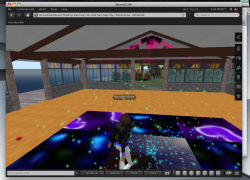
For class this week (and last week), we had to join Second Life, make an Avatar, and play around and explore for at least 3 hours. I had a really difficult time with the program! When I first joined, I met another girl on the program and added her as a friend. She gave me a beginners handbook for women in Second Life and I read a lot of it. I still had a lot of trouble going through the worlds, exploring, and just trying to figure out what the object of it all was. I could not figure out how to make money or buy things or build things. I was able to fly around, sit down and stand up, dance, roller skate, and other things. I felt like it was just a game that I was playing around in and did not seem like something educational or productive. It seemed very dangerous for students because there was a lot of sexual things on the site. I am still not sure I understand the educational aspects of Second Life. I suppose the Universities are a bit educational/different, but in general, I did not like Second Life. I never really got accustomed to the program or really figured out how to use it well enough I don't think. I don't think I would mind having class in Second Life, but I would want a direct link to exactly where I was supposed to be. It's such a pain to figure out how to get where I'm supposed to be! It would be neat to "see" your classmates (aka their Avatars). It would seem more like a real online classroom!
Inquiry Plan
| edt_598_inquiry_plan_outline.docx |
Research Paper
| research_paper.docx |

